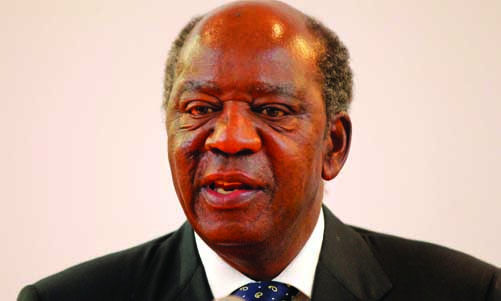By JAMES MUYANWA –
FINANCE Minister Alexander Chikwanda will today unveil the 2015 National Budget which is estimated to be between K43 billion and K46 billion.
The 2015 budget, which will be Mr Chikwanda’s fourth but the third truly Patriotic Front (PF) one, will be debated on by Members of Parliament up to early December this year when it is supposed to be adopted ahead of its effective date of January 1 2015.
It is highly probable to be above K43 billion since the 2014 one was K42.68 billion and lower than K46 billion because under the 2015-17 Medium Term Expenditure Framework (MTEF) the government projects a total budget of K45.98 billion for the year.
Of the total budget, about K34.3 billion or 18.9 per cent of the Gross Domestic Product (GDP) is expected to be domestically generated revenues as the grant category shrinks to about 0.8 per cent.
The big amounts of the budget in the recent-past years have been locally financed.
As Mr Chikwanda indicated in the 2014 national budget, the government will continue with the wage freeze to try and keep the public service wage bill within manageable levels by saving about K17 billion, next year alone.
This will create more fiscal space for developmental and service delivery expenditures.
In the main, the aim is to reduce expenditure on personal emoluments as a share of domestic revenues from the current 52.5 per cent to ultimately 45.8 per cent in 2017.
Going by the provision of the MTEF and other documents from Ministry of Finance, including the Revised Sixth National Development Plan, it is clear that the Activity-Based Budgeting will be abandoned in
preference for Output Based Budgeting which looks at the actual deliverables expected on the ground.
In sectoral terms, the economic affairs is yet again expected to take up a big chunk of the allocations with the road infrastructure likely to account for a large part, what with the Link Zambia 8000 and other on-going major road works.
Following the increase in the number of farmers under the Farmer Input Support Programme (FISP) to 1,000 per year, that programme will also take up a major portion of the resources in this category. Not forgetting the Food Reserve Agency (FRA) allocation!
To increase power generation, transmission and distribution considerable amounts of funds are expected to be allocated to Zesco and the Rural Electrification Authority.
Similarly, the Citizens’ Economic Empowerment Commission will surely receive a sizeable amount for onwards disbursement to the economic participants.
Under the general public services the notable entry will be the financing of the mooted Local Government Equalisation Fund, through which funding will be channeled to the local councils under a new arrangement based on domestic revenue generated.
Given the government’s commitment towards the education sector, the funding to that cardinal area is expected to increase from the K8.6 billion it was allocated this year.
The funds will facilitate the procurement of school requisites and the recruitment of teachers to improve the pupil-to-teacher ratio.
Other interventions under this function will include the phased construction of primary and secondary schools, new universities, hostels at existing universities and teachers’ accommodation.
The health sector, which received K4.2 billion under the 2014 budget, is another significant sector which is expected to receive augmented figures.
This will be for the usual health service delivery and to help finance several other innovations which are going on in this field.
On the revenue side, some changes are expected on the current mining tax regime to accommodate or address various issues which have arisen in the past few years.
The issues will include the continued assertion by citizens that the mining sector’s contribution toward the local national economy is not as much as it should and the way forward on the now contentious Zambia Revenue Authority Valued Added Tax (VAT) Rule 18.
Others are the 10-per cent penalty on the export of semi-processed mineral products and capital allowances.
As a recent statement by Parliamentary Media Liaison Officer Mathew Mukelabai indicated, the House is during this session expected to pass a number of budget-related legislations to authorise the executive to
spend the 2015 Budget and to operationalise government policy statements.
The expected bills include the Appropriation Bill, the Customs and Exercise (Amendment) Bill, the Income Tax (amendment) Bill, the Property Transfer Tax (Amendment) Bill and the VAT (Amendment) Bill.
Obviously, the employees countrywide are expectant to hear any changes in the Pay As You Earn (PAYE) threshold which will fully exempt a few more workers from not paying the personal income tax all together.
However, not much is expected in that area given the tight financial situation and, therefore, expecting another K800-per-month increase in exemption threshold would be expecting too much.
Through the adjustment of the threshold and the tax bands last year, the Government forewent K957 billion which is being retained by the employees.
Generally, the macroeconomic targets for 2015 will not significantly vary from the current ones and within the projections of the MTEF period.
The government policies are not anticipated to depart from the focus on the creation of at least 200,000 jobs per year as a way of reducing poverty and inequality on a sustainable basis.
This will, however, only be possible through investing in sectors that have been identified to best promote employment, add to productivity in the economy, lead to higher economic growth and develop the rural parts of the country.
The specific broad socio-economic policy targets could be a real GDP of more than seven per cent from this year’s projection of 6.5 per cent, maintenance of single-digit inflation of about seven per centand increase in the international reserves to more than three months of import cover.
Others could be the need to increase the domestic revenue as a percentage of the GDP thereby reducing on borrowing to ensure some semblance of self-sustainability.







